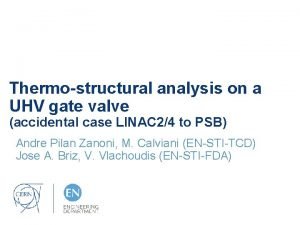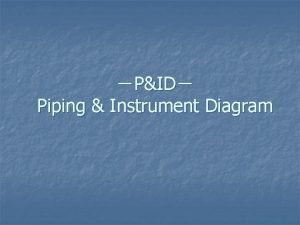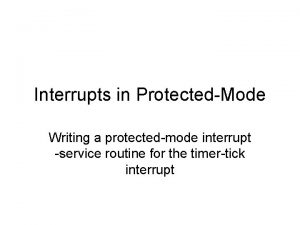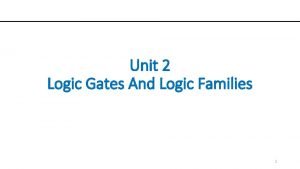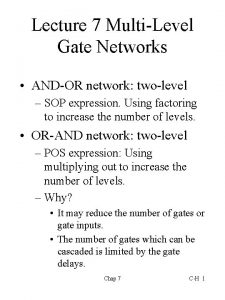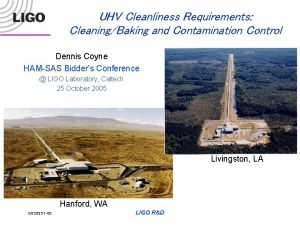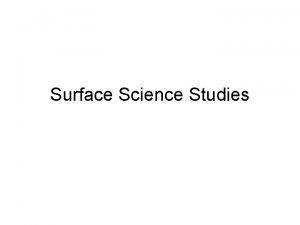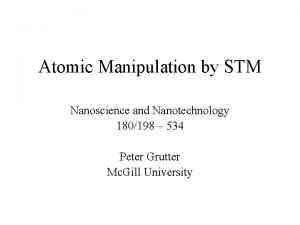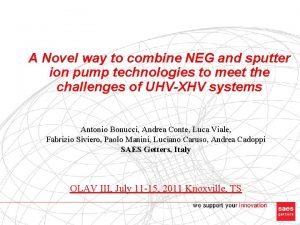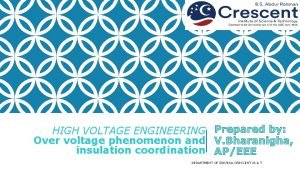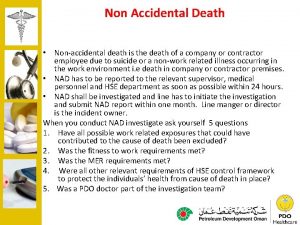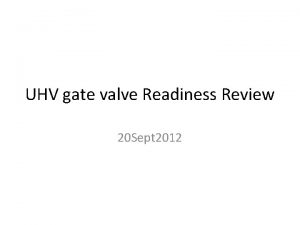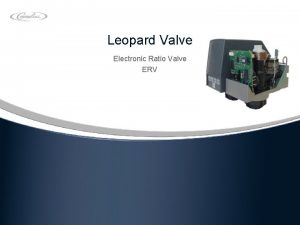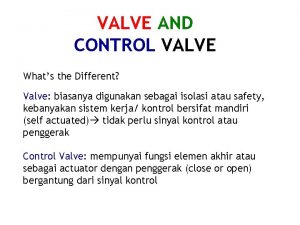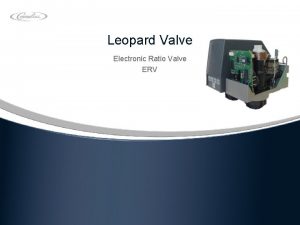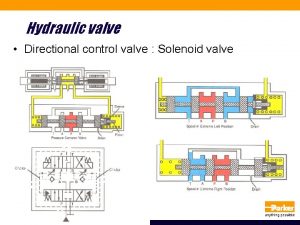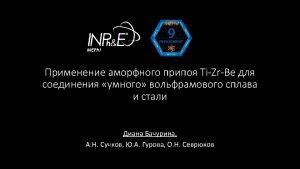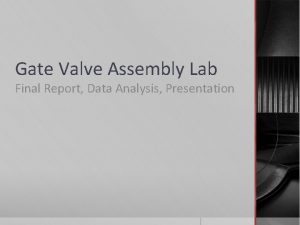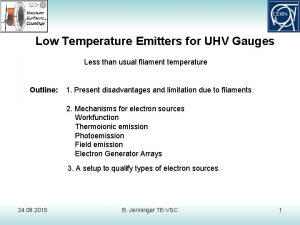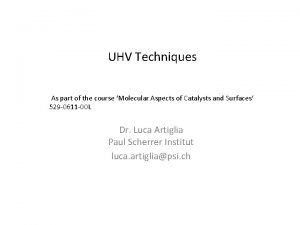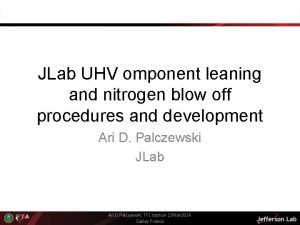Thermostructural analysis on a UHV gate valve accidental


















- Slides: 18

Thermo-structural analysis on a UHV gate valve (accidental case LINAC 2/4 to PSB) Andre Pilan Zanoni, M. Calviani (EN-STI-TCD) Jose A. Briz, V. Vlachoudis (EN-STI-FDA)

0. Valve type / position - UHV gate valve with pneumatic actuator - Series 10. 8, DN 63 - 200 (2½" - 8"), VAT Vakuumventile - Housing / mechanism material: AISI 304 (1. 4301) 2

1. Simulation conditions • Proton beam properties: • Case 1: • Case 2: • Energy: 50 Me. V • Energy: 160 Me. V • Size: σx = 2. 9 mm, σy=6. 4 mm • Size: σx = 1. 2 mm, σy=1. 9 mm • Intensity: 2. 3 x 1013 p+/pulse • Intensity: 1. 6 x 1013 p+/pulse • Pulse: 21. 7 µs • Pulse: 100 µs • Plate properties: • Size: 10 cm x 2 mm • Material: SS 304 L (ρ=8. 02 g/cm 3)

1. 1 50 Me. V proton beam BEAM Case 1: 50 Me. V, σx = 2. 9 mm, σy=6. 4 mm, I=2. 3 x 1013 p+/pulse

1. 2 160 Me. V proton beam BEAM Case 2: 160 Me. V, σx = 1. 2 mm, σy=1. 9 mm, I=1. 6 x 1013 p+/pulse

1. 3 Results

1. 4 Energy balance Beam type Energy deposited (Me. V/proton) Energy deposited (% of incoming energy) Energy deposited (J/pulse) Absorbed power (W) 50 Me. V 15. 7 31. 4 % 57. 8 48. 2 160 Me. V 6. 2 3. 9 % 15. 9 13. 3 Beam intensities considered: 2. 3 e 13 p/pulse for 50 Me. V 1. 6 e 13 p/pulse for 160 Me. V Beam repetition period: 1. 2 seconds for both beams

2. Thermal-structural analysis all four edges fixed • Repetition rate: 1. 2 s • Initial temperature: 22 o. C • FEM simulation (Ansys 17. 1) • SHELL 131/181 layered elements • 20 layers (see EDMS 1610806) • Boundary conditions: • Thermal: conduction through matter (neither convection nor radiation considered) • Mechanical: four edges fixed / bilinear isotropic hardening material model* *to account for permanent deformations 8

Stress strain curve 9

Results for two repeated pulses ΔT=140 K 151 s to 24 o. C ΔT=75 K 46 s to 24 o. C Maximum temperatures reached σeqv/σyield > 1 : plastic deformation 10

Multiple repeated pulses • No fracture for 40 repeated pulses (σeqv< σtensile) - Tensile strength is not reached after 40 repeated pulses (σeqv<σtensile) 11

Plastic deformation - εplastic, max ~ 200 mm/m - Rough prediction: between 900* and 1300** pulses until fracture starts * thermo-mechanical fatigue (model needs to be better studied) / ** linear extrapolation from results 12

Stress-strain curve (true stress) stress/strain 40 th pulse necking (only plastic strain) Multilinear model Curves from: Dempsey, J. Franklin, et al. "Temperature dependent ductile material failure constitutive modeling with validation experiments. " Challenges in Mechanics of Time-Dependent Materials and Processes in Conventional and Multifunctional Materials, Volume 2. Springer New York, 2013. 7 -15. 13

Border deformation Elastic strain after 40 pulses Plastic strain after 40 pulses - No plastic deformation on the border for 40 pulses - Plastic strain in the plate center: 13 mm/m -> 30 μm thru-thickness deformation - However steady-state temperature must be considered for irradiation over longer time 14

Steady-state results (50 Me. V) - Heat sink: radiation from the plate (ε=0. 6 to the environment) only - No convection - Conduction to the plate supports implemented - Maximum temperature: 523 o. C (operational limit at Tcreep=550 o. C) 15

Steady-state results (160 Me. V) - Heat sink: radiation from the plate (ε=0. 6 to the environment) only - No convection - Conduction to the plate supports implemented - Maximum temperature: 291 o. C (operational limit at Tcreep=550 o. C) 16

3. Conclusion • 2 repeated pulses: • ΔT 50 Me. V, max=75 o. C ΔT 160 Me. V, max=140 o. C • Plastic deformation after 1 pulse • However no permanent deformation on plate borders for 40 pulses • Structural limits for the plate: • Tmax, 50 Me. V=523 o. C (steady-state) • Tmax, 160 Me. V=291 o. C (steady-state) • Unclear how the material will behave over hundreds of pulses: • Further studies would be needed • For more information: EDMS 1758139 17

 Uhv gate valve
Uhv gate valve Sas gauges
Sas gauges Servo valve control circuit
Servo valve control circuit Gambar simbol pompa
Gambar simbol pompa Trap gate vs interrupt gate
Trap gate vs interrupt gate Not gate boolean expression
Not gate boolean expression Nand gate to and gate
Nand gate to and gate Uhv foil
Uhv foil Uhv aluminum foil
Uhv aluminum foil Formula of mean free path
Formula of mean free path Uhv
Uhv Uhv and xhv ion pump 40 l/s
Uhv and xhv ion pump 40 l/s Uhv session
Uhv session Overvoltage due to switching surges
Overvoltage due to switching surges Non accidental death examples
Non accidental death examples Non accidental death
Non accidental death Accidental fingerprint
Accidental fingerprint Accidental
Accidental Accidental insider trading
Accidental insider trading
